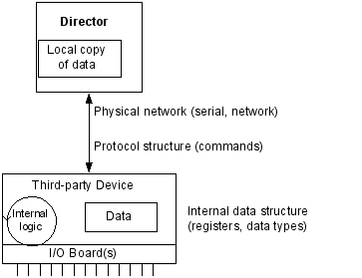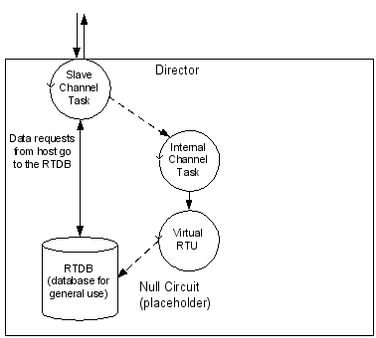
A substantial portion of the RediGate functionality relates to its ability to act as a protocol master to third-party devices, storing data locally in internal real-time databases, and using that stored data in a variety of ways. Because of the large number of interrelated ACE objects that potentially can make up a working Master Channel, it's important to understand Master Channels at a high level before trying to learn about each object's property configuration.
In the next few sections that follow, the "Master Channel" and related capabilities are described functionally using block diagrams. After that, the remaining sub-sections describe the ACE objects and their properties that are part of the Master Channels portion of the configuration.
The RediGate is capable of supporting many different protocol drivers, allowing it to communicate with third-party field equipment. Each type of equipment has its own unique communication protocol and data structure. The RediGate is described as a "master", because it initiates the communication to the other device.
In order to talk with the third-party equipment, a number of things need to be known about the communication network and the device. These are shown below in block diagram.

The RediGate must connect to the device (PLC, RTU, data concentrator) using some physical network – this might be over a network or a local serial port. It must send requests to the device using its native communication protocol and must request certain types of data from specified internal memory locations (registers) in the device. Once the RediGate retrieves the data from the third-party device, it stores a local copy in its internal Real-Time Databases (RTDB). From that point, other processes can use or re-transmit the data, or other host systems can request data from the RediGate.
In order for the RediGate to retrieve data from the device, the ACE configuration must include the following elements as a minimum:
In addition, the RediGate can be defined as a slave device to another master, allowing the other master to retrieve data that has been stored in the RTDB data areas. This requires one or more sets of Slave Channel elements to also be defined:
The normal polling sequence is as follows (numbers refer to the elements in the following diagram):

When an external master device requests data from the Slave Channel, the following sequence is observed:
If the host sends a command via the Slave Channel to set certain register values in the device, the following sequence is observed. Note that in this case the command is typically sent on a pass-through basis directly to the device, different from the previous sequence where data is requested from the RTDB:
Note that in the foregoing command sequence, no data is returned from the Field Unit to the RTDB. If the command sent from the master included writing data to the third-party device, that data is written directly to the device and does not exist in the RTDB unless a subsequent Master Channel polling process subsequently requests it, as described above in steps 1-4.
One of the features in the RediGate is the ability to define an ISaGRAF internal logic device (PLC) that operates as a stand-alone device within the system.
The Channel/RTU structure described in the previous section is very similar to the structure used for the ISaGRAF field unit. In this case, the RediGate uses an "Internal Channel" to communicate with the ISaGRAF field unit, whereas the Master Channel is used to communicate externally to other devices.
An ISaGRAF Field Unit may be thought of as a "virtual RTU". It is "virtual" because it doesn't exist as a separate device, but rather it resides inside the RediGate. As in the case of an external RTU, this ISaGRAF "virtual RTU" may contain I/O boards connected to field wiring, and may include programming logic. This is diagrammed below.

In order to preserve a logical consistency between the ISaGRAF channel and other Master Channels, an analogous structure of ACE objects is used for the Internal Channel.
Master Channel Structure | Internal Channel Structure (ISaGRAF) |
Master Channel: Defines polling sequence and timing to external devices | Internal Channel: Defines polling sequence and timing to internal |
Circuit: Defines which physical port to use for the connection (Async or Network) | Virtual Circuit: Defines a logical port to use for internal connection to ISaGRAF unit |
Field Unit: Specifies what protocol to use and which registers to poll. Note that different Field Unit definitions are used depending on the third-party device protocol. | ISaGRAF Field Unit: Specifies a specific type of field unit definition for the ISaGRAF unit, as well as which registers to poll. |
RTDB: Defines a data area in which to store data obtained from the device | RTDB: Defines data area in which to store data obtained from the ISaGRAF unit. Note that this is different from data stored internally within the ISaGRAF logic device. The RTDB is necessary if ISaGRAF data is to be used externally by other master systems or the HCP. |
In the case of a Master Channel, there are two locations where the data is stored. The external Field Unit contains certain data that are accessed using a protocol request. The RediGate contains an RTDB, which includes only the points of data obtained using the Master Channel polling.
For the ISaGRAF RTU the situation is analogous. One set of data resides inside the ISaGRAF RTU logic device and may contain any number of internal values. But only the data polled from ISaGRAF using the Internal Channel is available within the RTDB, which may be made available to other systems.
The data flow diagram for the ISaGRAF unit is shown below. Compare this with the data flow diagram for an external device (Master/Slave Channel Functional Elements).

When an external master device requests data using the Slave Channel, the following sequence is observed:
If the host sends a command to the Slave Channel for ISaGRAF, the following sequence is observed. Note that in this case the command is typically sent on a pass-through basis directly to ISaGRAF, different from the previous sequence where data is requested from the RTDB:
The ISaGRAF Workbench is one type of master that may be used with the ISaGRAF RTU. The Workbench issues special protocol messages which are passed to ISaGRAF, allowing the system designer to examine ISaGRAF internal registers, troubleshoot operation of the program, download a new ISaGRAF logic program, etc. The ISaGRAF Workbench must connect to the ISaGRAF RTU through a Slave Channel as described above in order to gain this special access to the ISaGRAF logic processing functionality. See the Elecsys ISaGRAF Manual for more information on using and programming the ISaGRAF RTU.
In addition to the special handling of the internal ISaGRAF RTU, the Internal Channel includes other child elements that provide special features within the system. These are the Virtual RTU, Status RTU, Segment RTU, and Internal Master. These are all connected to the Internal Channel using a "Null Circuit," which is simply a placeholder to preserve the normal Channel-Circuit-Field Unit structure. These types of field units are briefly explained here.
The Virtual RTU provides a data repository (RTDB) for internal storage of data, which is not connected with any external field device or ISaGRAF unit.

The Status RTU is another type of Virtual RTU, that can be used for storing data, but it has an additional purpose. When the RediGate is configured to poll one or more Field Devices using one or more Master Channels, there is some status information for each device such as poll count, current failed/good communication status, etc. These statistics for a whole set of Field Devices may be stored in the Modbus 40,xxx registers in the Status RTU, if desired, allowing a host system to manage communication statuses for all the field units in one place. See the section Communication Status Registers for more information on field unit status values.
The Segment RTU is another type of Virtual RTU, which allows for a more flexible structure of data. Most Real-time Databases (RTDB) have a structure something like this (exact point types and count are configurable):
Data type | Register addresses |
Boolean | 00,001 – 00,100 |
Boolean | 10,001 – 10,100 |
UINT16 | 30,001 – 30,100 |
UINT16 | 40,001 – 40,100 |
UINT32 | 41,001 – 41,100 |
The Segment RTU allows a more heterogeneous mix of register types and point counts. Rather than large "segments" of single data types (Boolean, UINT16) as listed above for a normal RTDB, the Segment RTU allows a flexible definition such as:
Segment RTDB Instance | Register type / Count |
1 | UINT8 2 |
2 | UINT325 |
And finally, the Internal Master is a virtual RTU/RTDB definition that has the special property of being able to consolidate data from any other RTDB databases. Normally, an RTDB under any Field Unit definition only contains the data polled from that device defined in the Field Unit. The Internal Master allows one or more RTDB locations to be defined and populated with a copy of certain data points from other RTDB's. Because the RTDB is used to present data to an external master device using a Slave Channel or HCP communication link, this allows data subsets to be created.
![]()
![]()
The Clients object is a placeholder for graphical clarity on the ACE tool, and provides a location to add client tasks to the configuration. Clients are generally tasks where the RediGate is initiating a connection "to" something else, such as to a field device or a network service.
| Attributes | Function |
|---|---|
| Object Type | Clients |
| Parent(s) | System |
| Instance | Must be 0 |
![]()
![]()
The Master Channels Identifier is a placeholder for graphical clarity on the ACE tool, and provides a location to add specific Master Channels (data concentrators) to the configuration.
| Attributes | Function |
|---|---|
| Object Type | Master Channels |
| Parent(s) | System → Clients |
| Instance | Must be 0 |
![]()
![]()
The DumpRTDB object provides a means to periodically flush all the contents of a real-time database to a system that uses report by exception (RBE), such as the Elecsys HCP or an MQTT server (MQTT RBE, JSON RBE, Sparkplug B). Normally, data is only reported upon change of state to conserve bandwidth. Flushing the database periodically requires more bandwidth, but might be preferred in cases where an additional measure of data integrity confirmation is desired. When using DumpRTDB, it is recommended to limit the size of the configured RTDB data points (RBE-enabled fields) to approximately the size of the actual number of used registers, to limit bandwitch usage to only needed data.
| Attributes | Function |
|---|---|
| Object Type | DumpRTDB |
| Parent(s) | System → Clients → Master Channels |
| Instance | Must be 0 |
| Properties | Values |
|---|---|
| Interval Delay | Scans between RBE data refreshes. If RBE Flag parater is set to "All DBM Flags", there is one interval delay per flag (interval x 4 for each flag). |
| RBE Flag | Which RBE Flags in DBM to set |
| Device List | Select which field units to enable RBE flags. If empty, update ALL RTDB's |


The HART Commands object provides HART command options for Field Unit HART objects' poll tables.
See the Protocol_HART-Master protocol documentation for information on configuring HART Commands.


The HART Command object specficies a particular HART command and defines data types and registers in which to store the data in responses from HART devices.
See the Protocol_HART-Master protocol documentation for information on configuring HART Commands.